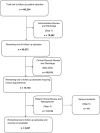A review of 145 234 ophthalmic patient episodes lost to follow-up
- PMID: 27834964
- PMCID: PMC5350359
- DOI: 10.1038/eye.2016.225
A review of 145 234 ophthalmic patient episodes lost to follow-up
Abstract
PurposeLost to follow-up and delays in follow-up care are a major problem in chronic diseases, particularly when irreversible progression precedes symptoms. The NPSA Glaucoma Safety Alert in 2009 highlighted the risk and requirements for consistent robust review systems in ophthalmology. In response, Moorfields Eye Hospital reviewed the records of all patients in all subspecialties without review appointments booked. The purpose of this study was to determine whether ophthalmic patients lost to follow-up had come to harm and develop investigation techniques to optimise safety, which do not put excessive demands on clinical staff time.MethodsThe health records of all patients lost to follow-up (LTFU) between July 2007 and November 2012 were reviewed for evidence of clinical harm using a risk-based strategy involving an initial administrative review, then a clinician led electronic patient record review, followed by a review of paper records by clinicians. The final stage was a clinical outpatient review where required determined by clinical risk.ResultsPatients identified as lost to follow-up were 145 234; 79 562 episodes were closed following administrative review; 50 519 were discharged following clinician examination of paper records; 12 316 patients required clinical review; and 16 serious incidents were identified, of which 14 patients had glaucoma, 1 a medical retinal condition with secondary glaucoma, and 1 an oculoplastic condition. A number of actions implemented hospital wide are described which minimise future risk.ConclusionRisk from delays or lost to follow-up care continue and require better capacity and more accurate data nationally.
Conflict of interest statement
The authors declare no conflict of interest.
Comment in
-
Comment on 'A review of 145 234 ophthalmic patient episodes lost to follow-up'.Eye (Lond). 2018 Feb;32(2):475. doi: 10.1038/eye.2017.186. Epub 2017 Sep 15. Eye (Lond). 2018. PMID: 28912513 Free PMC article. No abstract available.
-
Response to: 'Comment on A review of 145 234 ophthalmic patient episodes lost to follow-up'.Eye (Lond). 2018 Feb;32(2):475. doi: 10.1038/eye.2017.188. Epub 2017 Sep 15. Eye (Lond). 2018. PMID: 28912519 Free PMC article. No abstract available.
References
-
- Hospital Episode StatisticsHospital Outpatient Activity 2013–2014. Available at http://www.hscic.gov.uk/catalogue/PUB16722/hosp-outp-acti-2013-14-summ-r....
-
- National Patient Safety Agency Preventing delay to follow-up for patients with glaucoma. Available at Rapid Response Report 2009; NPSA/2009/RRR004.
-
- Department of Health. NICE glaucoma quality standard, March 2011. Available at http://www.nice.org.uk/guidance/qualitystandards/qualitystandards.jsp.
-
- National Institute of Clinical Excellence (NICE) guidance CG85. Glaucoma: diagnosis and management of chronic open angle glaucoma and ocular hypertension, April 2009. Available at http://guidance.nice.org.uk/CG85.
-
- Royal College of Ophthalmologists. 2014 New to follow up (N: F) ratios in ophthalmology outpatient services. Available at https://www.rcophth.ac.uk/wp-content/uploads/2014/12/2011_PROF_114_New-t....
MeSH terms
LinkOut - more resources
Full Text Sources
Other Literature Sources
Medical


